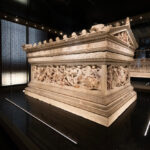Brunswig Mausoleum
Egyptian
Lucien Napoleon Brunswig (1854 – 1943) was a French emigre who spent his first years in the United States in Fort Worth, Texas working as a druggist. He combined his knowledge of pharmaceuticals with business acumen to create an empire that ensured financial rewards for himself and his successors.
- Early Experiences in the United States
- Philanthropy and Continued Success
- Coming Home: Lucien Napoleon Brunswig’s New Orleans Legacy
- Metairie Cemetery: Jewel of the Crescent City
Early Experiences in the United States
Lucien Brunswig arrived in Fort Worth, Texas from Monmedy, France in the late 1870s. After having established himself as a druggist in North Texas, Brunswig relocated to the Franco-friendly metropolis of New Orleans where he met and married Annie Mercer. The marriage produced a son, Lucien Mercer Brunswig, and daughter, Annie. While in New Orleans, Brunswig began to spread his business wings when he founded a pharmaceutical distributing company.
Lucien Mercer Brunswig died tragically just before his 10th birthday. Only one month later, Mrs. Annie Mercer Brunswig also died. Some years after both of these losses, Brunswig left New Orleans for Los Angeles, California. While in L.A., Brunswig became a partner in a local drug company. Brunswig also remarried while in Southern California. Ironically, Marguerite Wogan was a widow who had also previously lived in the New Orleans area.
Philanthropy and Continued Success
As his company continued to grow, Brunswig set his sights on returning the fruits of his success to the community. The School of Pharmacy at the University of Southern California was constructed thanks entirely to an endowment made by Brunswig to the school. Brunswig also selected smaller local endeavors to support as he continued to enjoy business success. In 1907, Brunswig bought his partner out and renamed the business to the Brunswig Drug Company. He also expanded into San Diego, Tucson, and Phoenix. At one point, and for a long period, Brunswig’s company was the city of Los Angeles’ largest wholesale drug supplier.
During World War I, the 63 year old Brunswig traveled back to France for eight months. As a representative of the ‘Friends of France’, Brunswig crafted essays detailing the effects of the war on his native France, including the scarring damage of battle, and efforts of reconstruction. Additionally, Brunswig wrote articles that highlighted prominent individuals and organizations.
Once back in Los Angeles, Brunswig continued his outreach efforts by founding the Cercle Catholique Francais, a volunteer organization aimed at providing assistance to recently arrived French immigrants. These type of fraternal organizations were very popular among immigrants in the late 1800s and early 1900s.
Despite mergers and name changes, the company founded by Brunswig is still in existence today. Upon his death, the company joined the Bergen Drug Company to become Bergen-Brunswig. In 2001, Bergen-Brunswig merged with AmeriSource Health Corporation and changed its name to AmerisourceBergen.
Coming Home: Lucien Napoleon Brunswig’s New Orleans Legacy
The Brunswig Mausoleum is in the famed Metairie Cemetery, which is located near New Orleans’ Garden District. Borrowing architectural design influences that date back to the time of the pharaohs, the Brunswig Mausoleum is a pyramidal structure similar to the Cimitero Monumentale in Milan, Italy. As Douglas Keister notes, “These pyramids are usually found with smooth granite sides, a sphinx and some sort of human figure.” The human figure at the Brunswig Mausoleum is a woman carrying a libation urn.
Because the sphinx is regarded as pagan architecture, most designers felt compelled to include a Christian symbol. However, it appears the Brunswig Mausoleum defies that custom, maintaining an ancient Egyptian style throughout.
Interred with Lucien Napoleon Brunswig are his first wife, Annie, their daughter Annie Brunswig Wellborn and her husband, and Henrietta Rosalie Brunswig, who is believed to be the first born daughter from Lucien’s second marriage.
Metairie Cemetery: Jewel of the Crescent City
The Metairie Cemetery is named for the road on which it is located and the Bayou Metairie. Visitors might think the cemetery is located in the nearby suburb of the same name, but it is actually located within New Orleans city limits. The city’s elevation just below sea level has required above-ground interment of deceased residents for generations. Throngs of visitors to New Orleans tour the city’s cemeteries and mausoleums because they are so unique.
Metairie Cemetery is widely regarded as having the largest collection of elaborate marble tombs and funeral statuary in the city. Several notable New Orleanians are interred at Metairie Cemetery. Among them are:
- Ruth Fertel, the founder of Ruth’s Chris Steak House
- Jim Garrison, former D.A. of New Orleans and subject of the Oliver Stone film JFK
- Mel Ott, Hall of Fame major league baseball player
- Louis Prima, legendary band leader
Like many individuals of this time, Lucien Napoleon Brunswig was a self-made man who sought and achieved a level of success experienced by a select few. Brunswig also shared his wealth with community by distributing his fortune among groups and organizations with which he felt a kinship. The gifts, endowments, and grants are as much a lasting legacy as the impressive Brunswig Mausoleum in which he is interred.
Photos and text © Douglas Keister Visit Doug’s Author Page
[address cemetery=”Metairie Cemetery” street=”5101 Pontchartrain Boulevard” city=”New Orleans” state=”Louisiana” zip=”70124″]

